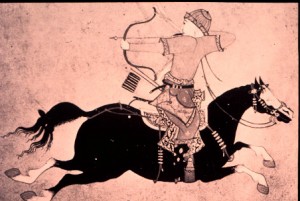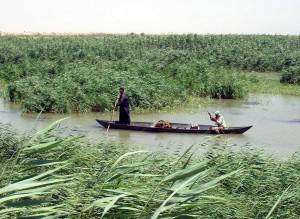Over the years there has been growing debate over whether civilization and the environment are integrally linked. Many scientists believe this to be the case, as it appears that several major events in the history of civilization have had an impact on the environment, while major environmental changes have also altered the course of human history. For instance, the Mongolian conquest of the 13th and 14th centuries altered carbon emissions, whereas the Roman Empire flourished during a period of rich summers, and subsequently fell apart during a period of erratic seasons.
 Recently, scientists have uncovered evidence that suggests the Mongolian conquest of large portions of Asia, the Middle East and Europe may have had an impact on carbon dioxide emissions. When the Mongolians invaded these areas, they often destroyed entire crops, severely affecting the regions’ agriculture. As a result, many farms were abandoned, allowing the forests to take over the land. Thus, during 13th and 14th centuries, these forests were able to grow markedly and absorb huge amounts of carbon dioxide. The study claims that the total decrease in carbon dioxide during this period would be enough to cancel out one year of modern carbon emissions from gasoline. Yet it is important to remember that the Mongolian period of conquest extended across almost two centuries, which means that the actual yearly reductions were relatively insignificant in comparison with our current level of emissions. Nonetheless, the study does show that major events in human society are capable of having an impact in on the environment.
Recently, scientists have uncovered evidence that suggests the Mongolian conquest of large portions of Asia, the Middle East and Europe may have had an impact on carbon dioxide emissions. When the Mongolians invaded these areas, they often destroyed entire crops, severely affecting the regions’ agriculture. As a result, many farms were abandoned, allowing the forests to take over the land. Thus, during 13th and 14th centuries, these forests were able to grow markedly and absorb huge amounts of carbon dioxide. The study claims that the total decrease in carbon dioxide during this period would be enough to cancel out one year of modern carbon emissions from gasoline. Yet it is important to remember that the Mongolian period of conquest extended across almost two centuries, which means that the actual yearly reductions were relatively insignificant in comparison with our current level of emissions. Nonetheless, the study does show that major events in human society are capable of having an impact in on the environment.
Another study, published in the Feb. 4 issue of Science magazine, also demonstrates the relationship between civilization and the climate. According to the authors of the study, the height of the Roman Empire occurred during a period when the growing season was consistently experiencing optimal conditions. Such conditions provided great economic wealth and the means to uphold the structure of the empire. Thus, the citizens of lands conquered by the empire were much less likely to show dissent.
Conversely, the collapse of the Roman Empire occurred during a period of erratic environmental conditions (perhaps partly due to agricultural overproduction within the empire) that yielded poor or mediocre crops. Without a steady food-supply, the empire faced dissent among its citizens. As the power structure was threatened within, the empire became susceptible to invasion from without and collapsed. In this way, environmental factors defined two of the largest events in Western history: the rise and fall of the Roman Empire.
Jared Diamond expounds upon this idea in his book “Guns, Germs, and Steel.”
According to Diamond, geographical determinism has defined the prosperity of American society. For instance, the vast natural resources of the country spurred our economy tremendously in the early days of the industrial revolution and our physical isolation from the rest of Western society has allowed us to remain prosperous after two world wars. Clearly, much of what makes America dominant is the physical geography that defines it as a nation.
Although the world’s booms and busts have been influenced by environmental factors, ultimately it seems that civilization has had a much larger impact on the environment. In the last 300 years, human population has increased by a factor of 10. Two worldwide wars have been fought and industrial growth has continued to increase in developed and under-developed countries at an unprecedented level. While many of these developments have been beneficial to civilization, the impact on the environment has not been so positive.
One of the negative effects brought about by civilization is the trend of global warming. Since 1750, human beings have steadily increased their production of carbon dioxide, methane, nitrous oxide and other greenhouse gases. These gases are emitted into the atmosphere as by-products of fossil fuel burning, agriculture (in fertilizers and from increased numbers of livestock) and other industrial products, such as refrigerants and aerosols. The greater concentration of these gases in the atmosphere increases the atmosphere’s ability to retain heat radiated from the sun or earth’s surface. Thus, we are experiencing global warming: an increase in the average global temperature. This increase amounts to about 0.74 degrees Celsius. While a difference of less than one degree may seem inconsequential, the average global temperature has only shown an increase of six degrees Celsius since the ice age, which means environmentalists and scientists both have every reason to be concerned about the state of our ecosystem.
By drawing from scientific studies and historical examples, we can clearly see civilization is integrally linked to the environment. Like Genghis Khan, we haven’t undertaken our endeavors with the purpose of changing the environment. Nonetheless, the implementation of large-scale activities such as automobile use, airplane travel, and even war, have significantly impacted the environment and may have very serious consequences for civilization. However, unlike Genghis Khan, we have the scientific knowledge to evaluate and limit the negative consequences of our actions. Hopefully, we will be able to learn from history in time to make a difference.
Author
Ashley Warner is a graduate student working toward her Masters in Conservation Biology. She currently resides in Washington state.


